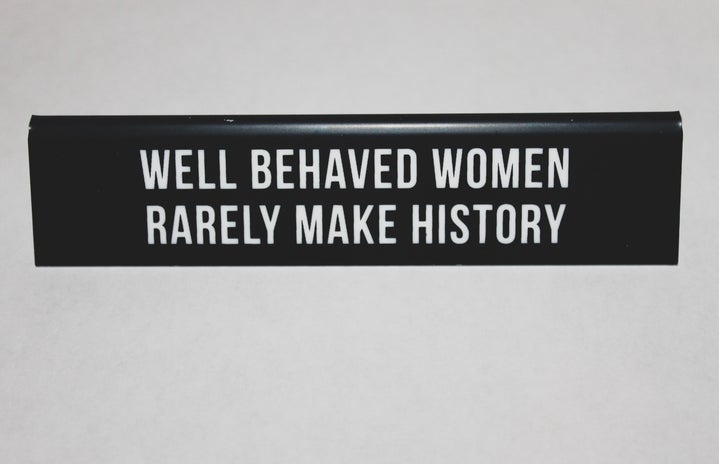Imagine a world where your sole purpose was to serve a husband you’d never love, obey a country you’d never have rights to, and bear children you’d never raise.
That is the dystopian world the Hulu adaption of Margaret Atwood’s 1985 novel, ‘The Handmaid’s Tale.’
In ‘The Handmaid’s Tale,’ the United States has been overthrown by a fundamentalist regime that treats women as property of the state. Most women in this new world are barren, so the regime uses passages from the Bible to justify forcing enslaved women – or handmaids – to bear children for government officials.
What makes ‘The Handmaid’s Tale’ so horrifying isn’t their barbaric treatment of women or even the mystifying villains that are found in modern society; it is how realistic the fabled country of Gilead came to power. Through a series of flashbacks, ‘The Handmaid’s Tale’ shows that the nation wasn’t overthrown in one night. A slow introduction of radical ideas made closeted bigots feel more comfortable speaking out against women’s rights. As this extreme party of fundamentalists took hold of the government, the show follows June – renamed Offred to show possession of her rapist, Commander Fred – stripped of her rights and forced in to slavery.
There are many lessons taught in ‘The Handmaid’s Tale,’ all which women need to see in this harrowing show.
1. There is a diverse cast of flawed, genuine characters
Unlike many television shows that follow the archetype of brooding male, smart yet sexy female side-kick/love interest, and minority best friend, ‘The Handmaid’s Tale’ puts women front and center. The main character is Offred, who is a woman with a multifaceted past. While Offred is a mother, she is still shown as a human being outside of that role. Motherhood plays a central theme to ‘The Handmaid’s Tale,’ but Offred has a life outside of being a mom that includes her friends, successful career, and hobbies. Offred is also far from perfect. She convinced her current husband to leave his wife for her, and struggles throughout the show figuring out if he truly respects her.
There is plenty of screen time for Offred’s best friends Moira and Ofglen, both who are lesbians. While the show touches on gay rights in this alt-right dystopia, Moira and Ofglen’s sexual orientation is not the only defining attribute central to their character. They help fuel rebellion with the other enslaved women, protect their loved ones, and have aspirations of their own.
Without revealing too many characters central to the plot, most of the cast are multifaceted women with flaws and perfections alike. It isn’t so much “girl power” as it is accurate representation of women struggling for their rights in an oppressive society.
2. The plot is centered on political issues over romance
For some reason shows tend to be written off as “chick-flicks” whenever the main character is female. Writers seem to find love triangles and petty drama central to developing female characters, making audiences ask “Peeta or Gale?” over “revolution or hivemind?”.
The story is about women who are raped in a patriarchal society to ensure the survival of humanity. Fortunately for viewers, that leaves little time for crushes. The only romantic topics that are discussed are central to the political statements being made.
Offred slept with a married man: does that make her just as much as an adulterer? Why does Commander Fred take Offred’s submissiveness as harbored attraction? What new laws in the country of Gilead make it dangerous for a woman to leave her husband?
Yes, there is a dash of love interests that I will omit to prevent spoilers. But after every episode viewers aren’t rooting for Offred to fall in love. They want her to survive.
3. Many laws featured in the show reflect current laws in the United States
In Gilead, couples are not legitimate unless they are legally married. In Mississippi and Michigan, if a man and a woman are proven to be living together and having “habitual sexual intercourse,” they can be fined and put in jail up to six months.
However, some of the laws are more enforced in modern society. Abortion is outlawed and fetuses are required to have funerals (more represented in the novel version). There are currently laws being signed in the United States that restrict abortion rights, underfund Planned Parenthood, and allow doctors to hide possible defects in unborn children to prevent abortion.
Many of the laws in Gilead reflect a lack of consent from the handmaids, which can be found in the United States as well. There are laws in Maryland that require rape victims to negotiate with their accused rapists for custody rights, like giving parental rights to the men raping the handmaids. Handmaids may also not revoke consent during sex, even if there is violence, which is similar to a loophole in North Carolina’s state law on sex and consent, set by a 1979 State Supreme Court case, that states it is not considered rape if a woman agreed to sex initially, even if she later revokes her consent despite her partner becoming violent.
4. More than just women’s rights are represented
‘The Handmaid’s Tale’ touches on every social topic imaginable. Some of these include:
- Spousal rape
- Genital mutilation
- Gay rights
- Same-sex marriage
- Slavery
- Abortion
- PTSD
- Mental illness
- Family structure
- Hook-up culture
- Religious rights
- Motherhood
- Men’s rights
- Distribution of wealth
- Fascism
Just when you think ‘The Handmaid’s Tale’ has played on your biggest fear, the show finds another way to bring it to life.
5. It’s eerily realistic
As stated before, Gilead did not become a country overnight. As radical ideas became introduced, bigots felt more at ease to speak their mind. There is a flashback scene where Offred and Moira order coffee after a run, and the male barista calls them ‘sluts’ for wearing shorts.
The country slowly closed all women’s bank accounts; moving their money over to their husbands and fathers. It was then outlawed for women to hold jobs, and slowly the ones proven to be fertile were taken away.
This can happen, and in some societies, already has.
There are plenty of articles trying to conspire what ‘The Handmaid’s Tale’ represents. Some believe it is a parody of a truly patriarchal society in which women are completely at bay to their male counterparts. There are also some – mostly written by men – that think it is a representation of the family structure falling apart in loveless marriages.
What ‘The Handmaid’s Tale’ truly is happens to be a warning. It is a warning to stand up against ideals you disagree with. Fight laws that oppress minorities. Protect your rights before they are taken away.
If the handmaid represents someone in society who is stripped of all power, then her tale is gaining that power back.



